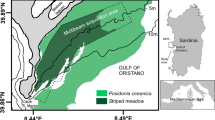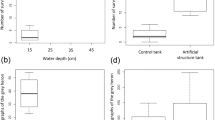Abstract
Four compartments of a salmonid brook were studied in consecutive sections either at sector scale or at facies scale: physical features, water quality, macrophytes and salmonids. The most important factor in the spatial and temporal organisation was the longitudinal zonation assessed by the four compartments. It was mainly shown by a gradient of the length of the morphodynamic sequence and of the facies width, of the pH and the conductivity and of macrophyte cover. It induced a colonisation by older trout in the downstream part of the brook where growth was better and shelter given by the bankside vegetation was more abundant. There were also greater densities of other age-classes upstream, with a correlation between salmon and rock shelter. Furthermore, the second factor corresponded to the flow characteristics and a granulometry gradient. The third factor corresponded chiefly to lighting, salmon numbers and densities. Salmonids showed a temporal stability from spring to autumn,and an opposition between growth and density. Six clusters of sectors defined functional entities. With regard to the 3—dimensitnal structure of the brook, the special pattern of each compartment shows its contribution to the functioning of the whole. Taking into account the scale of the study, the coexistence between trout and salmon did not show a competition between the two species, but rather a spatial partition, thanks to thehheterogenity inside each sector. We concluded on the necessity of studying sympatry at the facies scale to assess the role of habitat factors as regulators of carrying capacity.
Résumé
Quatre compartiments d’un ruisseau á salmonidés ont été étudiés dans des secteurs consécutifs, á l’échelle du secteur ou du faciés: le milieu physique, la qualité de l'eau, les macrophytes et les salmonidés. Le phénoméne majeur pour l'organisation spatio-temporelle est la zonation longitudinale, manifestée par les quatre compartiments. Cette zonation se traduit par un gradient de longueur de séquence morpho-dynamique et de largeur des faciés, du pH et de la conductivité et du recouvrement macrophytique. Les truites ăgées colonisent essentiellement l'aval oú la croissance est meilleure et les abris offerts par la végétation rivulaire plus abondants. Les densités des autres classes d'ăge de salmonidés sont plus importantes á l'amont, avec une corrélation positive entre abris minéraux et densité de saumons. Par ailleurs, le second facteur correspond aux caractéristiques de l'écoulement et au gradient granulométrique. Le troisiéme facteur est principalement déterminé par l'éclairement, ainsi que par les effectifs et densités de saumons. Les salmonides montrent une stabilité temporelle printemps—automne et une opposition croissance-densité. Six ensembles de secteurs définissent des entités fonctionnelles. Au vu de la structure tri-dimensionnelle du ruisseau, le patron propre á chaque compartiment traduit sa participation au fonctionnement de l'ensemble. Compte-tenu de l'échelle d'étude, la coexistence entre Truite et Saumon ne se manifeste pas par une compétition entre les deux espéces, mais plutôt par un partage de l'espace grâce aux hétérogénéités intra-secteurs. Aussi s'avére-t-il nécessaire d'étudier la sympatrie á l'échelle du faciés pour mettre en évidence le rôle des flacteurs d'habitat comme régulateurs de la capacité d'accueil.
Similar content being viewed by others
References
Bagliniére, J. L. & D. Arribe-Moutounet, 1985. Microrépartition des populations de truite commune (Salmo trutta L.) et des autres espéces présentes dans la partie haute du Scorff (Bretagne). Hydrobiologia 120: 229–239.
Bagliniére, J. L. & A. Champigneulle, 1986. Populations estimates of juvenile Atlantic Salmon (Salmo salar) as indices of smolt production in the River Scorff, Brittany. J. Fish Biol. 29: 467–482.
Bagliniére, J. L., A. Champigneulle & A. Nihouarn, 1979. La fraie du saumon atlantique (Salmo talar L.) et de la truite commune (Salmo trutta L.) sur le bassin du Scorff. Cybium, 3éme sér. 7: 75–96.
Bagliniére, J. L., G. Maisse, P. Y. Le Bail & A. Nihouarn, 1989. Population dynamics of brown trout (Salmo trutta L.) in a tributary in Brittany (France): spawning and juveniles. J. Fish Biol. 34: 97–110.
Bagliniére, J. L., G. Maisse & A. Nihouarn, 1993. Comparison of two methods of estimating Atlantic Salmon (Salmo salar) wild smolt production. In R. J. Gibson & R. E. Cutting (eds), The production of juvenile Atlantic salmon, Salmo salar, in natural waters. Can. Fish. aquat. Sci., spec. Bull. 118: 189–201.
Escofier, B. & J. Pages, 1988. Analyses factorielles simples et multiples- Objectifs, méthodes et interprétation. Dunod Paris, 241 pp.
Gibson, R. J. & R. A. Cunjak, 1986. An investigation of competitive interactions between Brown Trout (Salmo trutta L.) and juvenile Atlantic Salmon (Salmo salar L.) in rivers of the Avalon Peninsula, New Foundland. Can. techn. Rep. Fish. aquat. Sci. 1472, 82 pp.
Gibson, R. J. & R. E. Cutting (eds), 1993. The production of juvenile Atlantic salmon, Salmo salar, in natural waters. Can. Fish aquat. Sci., spec. Bull. 118, 262 pp.
Haury, J., 1985. Etude écologique des macrophytes du Scorff (Bretagne-Sud). Thés. Dr-Ing. Ecologie Univ. Rennes I, 243 pp.
Haury, J. & J. L. Bagliniére, 1990. Relations entre la population de truites communes (Salmo trutta L.), les macrophytes et les paramétres du milieu sur un ruisseau. Bull. fr. Pêche Piscic. 318: 118–131.
Haury, J., D. Ombredane & J. L. Bagliniére, 1991. L'habitat de la truite commune (Salmo trutta L.) en riviére. In J. L. Bagliniére & G. Maisse (eds), La Truite: Biologie et Ecologie. INRA Paris: 47–96.
Heggenes, J. & S. J. Saltveit, 1990. Seasonal and spatial microhabitat selection and segregation in young Atlantic salmon, Salmo salar L., and brown trout, Salmo trutta L., in a Norwegian river. J. Fish Biol. 36: 707–720.
Maisse, G. & J. L. Bagliniére, 1991. Biologie de la truite commune (Salmo trutta) dans les riviéres francaises. In J. L. Baglinére & G. Maisses (eds), La Truite: Biologie et Ecologie. INRA Paris: 25–46.
Malavoi, J. R., 1989. Typologie des faciés d'écoulement ou unités morpho-dynamiques des cours d'eau á haute énergie. Bull. fr. Pêche Piscic. 315: 189–210.
Pages, J., B. Escofier & J. Haury, 1991. Multiple factor analysis: a method to analyse several groups of variables measured on the same set of individuals. In J. Devillers & W. Karcher (eds), Applied Multivariate Analysis in SAR and ENVIRONMENTAL Studies, ECSC, EEC, EAEC, Brussels and Luxembourg: 33–83.
Author information
Authors and Affiliations
Rights and permissions
About this article
Cite this article
Haury, J., Bagliniére, J.L., Cassou, A.I. et al. Analysis of spatial and semporal organization in a salmonid brook in relation to physical factors and macrophytic vegetation. Hydrobiologia 300, 269–277 (1995). https://doi.org/10.1007/BF00024467
Issue Date:
DOI: https://doi.org/10.1007/BF00024467




